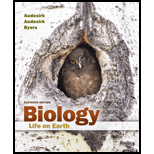
Concept explainers
Density-independent environmental resistance includes
predation.
parasitism. floods.
competition.
Introduction:
Environmental resistance plays an important role in combating the exponential growth of a population. It occurs through both density-dependent and density-independent mechanisms. As the name suggests, density-independent mechanisms of limiting population do not depend on density-related factors, e.g. is climate. On the other hand density-dependent factors depends on density and include factors like prey–consumers interactions.
Answer to Problem 1MC
Correct answer:
Floods is a density-independent environmental resistance.
Explanation of Solution
Explanation/justification for the correct answer:
Option (b) is given that the floods. This is a correct option as flood is classified as a weather or climatic condition that occurs independent to the density of the population but can have a drastic effect on the population. Density-independent factors involve weather and climate. These factors exert influence on the size of the population irrespective of the density of the population. Hence, option (b) is correct.
Explanation for the incorrect answers:
Option (a) is given that predation is a density-independent environmental resistance. This is incorrect as predation is a density-dependent environmental condition. An increase in density of prey makes predation easier. So, it is an incorrect option.
Option (c) is given that the parasitism is a density-independent environmental resistance. This is incorrect as parasitism is a density-dependent environmental condition. Increase in density is correlated to increase in parasitism. So, it is an incorrect option.
Option (d) is given that competition is a density-independent environmental resistance. This is incorrect as competition is a density-dependent environmental condition. Increase in density leads to an increase in competition. So, it is an incorrect option.
Hence, options (a), (c), and (d) are incorrect.
Thus, it can be concluded that floods can be classified as a density-independent environmental resistance.
Want to see more full solutions like this?
Chapter 27 Solutions
Biology: Life on Earth (11th Edition)
- Identify the indicated tissue? (stem x.s.) parenchyma collenchyma sclerenchyma ○ xylem ○ phloem none of thesearrow_forwardWhere did this structure originate from? (Salix branch root) epidermis cortex endodermis pericycle vascular cylinderarrow_forwardIdentify the indicated tissue. (Tilia stem x.s.) parenchyma collenchyma sclerenchyma xylem phloem none of thesearrow_forward
- Identify the indicated structure. (Cucurbita stem l.s.) pit lenticel stomate tendril none of thesearrow_forwardIdentify the specific cell? (Zebrina leaf peel) vessel element sieve element companion cell tracheid guard cell subsidiary cell none of thesearrow_forwardWhat type of cells flank the opening on either side? (leaf x.s.) vessel elements sieve elements companion cells tracheids guard cells none of thesearrow_forward
- What specific cell is indicated. (Cucurbita stem I.s.) vessel element sieve element O companion cell tracheid guard cell none of thesearrow_forwardWhat specific cell is indicated? (Aristolochia stem x.s.) vessel element sieve element ○ companion cell O O O O O tracheid O guard cell none of thesearrow_forwardIdentify the tissue. parenchyma collenchyma sclerenchyma ○ xylem O phloem O none of thesearrow_forward
- Please answer q3arrow_forwardRespond to the following in a minimum of 175 words: How might CRISPR-Cas 9 be used in research or, eventually, therapeutically in patients? What are some potential ethical issues associated with using this technology? Do the advantages of using this technology outweigh the disadvantages (or vice versa)? Explain your position.arrow_forwardYou are studying the effect of directional selection on body height in three populations (graphs a, b, and c below). (a) What is the selection differential? Show your calculation. (2 pts) (b) Which population has the highest narrow sense heritability for height? Explain your answer. (2 pts) (c) If you examined the offspring in the next generation in each population, which population would have the highest mean height? Why? (2 pts) (a) Midoffspring height (average height of offspring) Short Short Short Short (c) Short (b) Short Tall Short Tall Short Short Tall Midparent height (average height of Mean of population = 65 inches Mean of breading parents = 70 inches Mean of population = 65 inches Mean of breading parents = 70 inches Mean of population = 65 inches Mean of breading parents = 70 inchesarrow_forward
 Biology Today and Tomorrow without Physiology (Mi...BiologyISBN:9781305117396Author:Cecie Starr, Christine Evers, Lisa StarrPublisher:Cengage Learning
Biology Today and Tomorrow without Physiology (Mi...BiologyISBN:9781305117396Author:Cecie Starr, Christine Evers, Lisa StarrPublisher:Cengage Learning Human Biology (MindTap Course List)BiologyISBN:9781305112100Author:Cecie Starr, Beverly McMillanPublisher:Cengage Learning
Human Biology (MindTap Course List)BiologyISBN:9781305112100Author:Cecie Starr, Beverly McMillanPublisher:Cengage Learning Biology (MindTap Course List)BiologyISBN:9781337392938Author:Eldra Solomon, Charles Martin, Diana W. Martin, Linda R. BergPublisher:Cengage Learning
Biology (MindTap Course List)BiologyISBN:9781337392938Author:Eldra Solomon, Charles Martin, Diana W. Martin, Linda R. BergPublisher:Cengage Learning
 Concepts of BiologyBiologyISBN:9781938168116Author:Samantha Fowler, Rebecca Roush, James WisePublisher:OpenStax College
Concepts of BiologyBiologyISBN:9781938168116Author:Samantha Fowler, Rebecca Roush, James WisePublisher:OpenStax College





